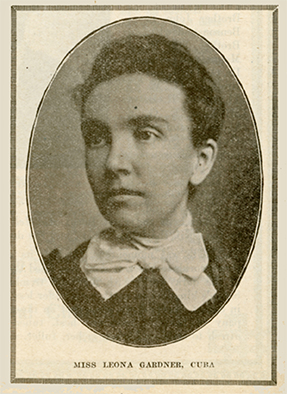Written by Stan Ingersol
From his column Past to Present
Haga clic aquí para ver esto en español

Leona Gardner was born in Maury County, Tennessee, on November 10, 1868. Her father, John Milton Gardner, was a local preacher in the Methodist Episcopal Church, South. She learned about the grace of entire sanctification from a relative, studied the Scriptures, and was led into the grace by Rev. Johnson, the circuit’s senior pastor. Eleven months later, her father also accepted the experience, which he always called “Perfect Love.”[2]
She assisted a female evangelist for a while. In Nashville, she met the McClurkans. The Pentecostal Alliance was the Christian and Missionary Alliance’s southern sister, dedicated to home and foreign missions. They issued Gardner an evangelist’s license in 1899.
McClurkan reorganized the work into the Pentecostal Mission in 1901 and launched Trevecca as a literary and training school for Christian workers. Gardner attended the school briefly. In late 1901, the Mission appointed missionaries for Guatemala and Colombia.
Leona Gardner and Rev. and Mrs. John Boaze set sail for Colombia in January 1902. In Havana, they learned that political and social conditions in Colombia were not conducive to their ministry, so they decided to remain in Cuba, settling in the coastal city of Trinidad.
Trinidad had scores of sugar cane mills amid a population of 30,000 people. They began mission work, but the Boazes returned to the United States in 1905. Leona Gardner remained in Cuba for another 23 years. She taught, preached, and functioned as a bivocational missionary by teaching English to Cubans. This supplemented her missionary wage and met government work requirements as an immigrant. She was not completely alone. She had Cuban colleagues like Teofilo Castellana, a licensed evangelist since 1902, who also worked in Trinidad.
She experienced cultural prejudice against female leadership, along with anti-Protestant bias, but Gardner moved on with dogged determination, committed to the welfare of the souls entrusted to her pastoral care. The work extended into nearby Casilda.
McClurkan died in 1914, and the Pentecostal Mission united with the Nazarenes the next year. General Superintendent Hiram Reynolds visited Cuba in 1916, meeting Gardner and preaching in Trinidad and Casilda.
Gardner wrote him soon after the visit. She noted, “I have had to labor here against so many prejudices against women preaching.” A major source of opposition to her ministry came from Baptists “who think the experience we preach and profess is impossible.” She thanked Reynolds, saying that his presence had given “authority to woman’s work” and strengthened the witness to Christian holiness.[3]

She was reluctant to take furloughs, because she wasn’t sure the church would send her back to Cuba, but health issues forced her to return to the U.S. a few times.
In 1927, the Nazarene Department of Foreign Missions decided to relocate her to Guatemala, and she accepted the decision. For a year, she supervised the mission in Salama led by Rev. and Mrs. R. C. Ingram while they took a furlough. When they returned, she moved to Puruhla, some 25 miles away, to be a minister and teacher to the indigenous people. She lived in the back room of a cane-thatched adobe house and held religious services in the front room.
She wrote: “My calling is to preach and teach the Word to those who need it, and to live among the people, thus in a measure entering into their thought and sympathizing with them in their poverty.”[4]
In 1932, she moved to Lake Peten, near the Mexican border. By 1934 she was also ministering (in Spanish and English) in Benque Viejo, British Honduras (now Belize), which borders Guatemala. Missionary Richard Birchard called her a “living heroine of the cross.”[5]
The intrepid missionary retired in 1938. The mission board inquired about her ordination status, to which she replied: “I am sorry to say that my long residence in the Foreign Field caused me not to have the opportunity for ordination.” She noted that she had preached and performed pastoral work, noting wistfully, “I should have appreciated very much the ordination that the Church of the Nazarene would have given me.”[6]
Leona Gardner died in Nashville in 1944. She was laid to rest in Maury County near other family members in the Goshen Methodist Church cemetery.
Dr. Stan Ingersol, Ph.D., is former manager of the Nazarene Archives.
[1]One of the licensed evangelists was Frances Rye McClurkan, the wife of the Pentecostal Mission’s founder. After his death, she was ordained as an elder by the Nazarenes.
[2]Leona Gardner, autobiographical sketch, manuscript, p3, Leona Gardner Collection, Nazarene Archives.
[3]Leona Gardner to H. F. Reynolds, March 22, 1916. Hiram F. Reynolds Collection, Nazarene Archives.
[4]Autobiographical sketch, p. 6.
[5]Richard W. Birchard, “A Missionary Heroine of Guatemala,” Other Sheep (Dec. 1935): 20-21
[6]Quoted by Rebecca Laird in Ordained Women in the Church of the Nazarene (1993): 137.
